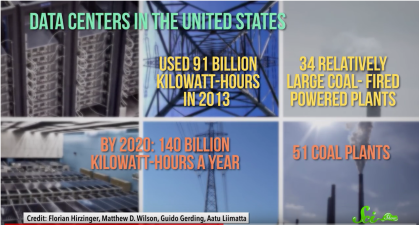As any journalist can tell you (probably off the record), Google’s press police hammers the message of the day very aggressively. We have a perfect example of those Googlely antics with their latest charm offensive on new data centers in Europe.
Here’s the headline from The Street, which is very likely actual reporting on the story:

Not a word in the story about “clean” anything, probably because the reporters know better and are probably insulated from Google’s press police.
But–here’s the same story from TechCrunch:

This TechCrunch headline ran over a huge photo of wind turbines–which has little to do with the story which is not about wind farms but about data farms. Data farms that hog huge amounts of electricity.
Google typically requires a state–or in the EU’s case a nation–to provide a mix of energy sources, about 1/3 of which Google would like to derive from “green” sources. But not all. However, the TechCrunch story makes it sound like the whole point of the data centers isn’t to hog electricity and crowd out local power users but instead to somehow “answer the call” by climate strikers by doing something they would have done anyway–when they KNOW they are burdening the local power grid.
Google announced today that it was investing €3 billion (approximately US$3.3 billion) to expand its data center presence in Europe. What’s more, the company pledged the data centers would be environmentally friendly….
It’s obviously not a coincidence that the company is making an announcement related to clean energy on Global Climate Strike Day, a day when people from around the world are walking out of schools and off their jobs to encourage world leaders and businesses to take action on the climate crisis. Google is attempting to answer the call with these announcements.

- Google emits less than 8 grams of carbon dioxide equivalent per day to serve an active Google user—defined as someone who performs 25 searches and watches 60 minutes of YouTube a day, has a Gmail account, and uses our other key services.
In Google-speak “less than 8” usually means 7.9999999999. So let’s call it 8. As of 2016 there were 1 billion active gmail users. So rough justice, Google acknowledges that it emits about 8 billion grams of carbon dioxide daily, or 9,000 tons. And based on the characteristically tricky way Google framed the measurement, that doesn’t count the users who don’t have a gmail account, don’t use “our other key services” and may watch more than an hour a day of YouTube. You know, like kids for example.
Upload your latest holiday photos to Facebook, and there’s a chance they’ll end up stored in Prineville, Oregon, a small town where the firm has built three giant data centres and is planning two more. [Hello, Senator Wyden.] Inside these vast factories, bigger than aircraft carriers, tens of thousands of circuit boards are racked row upon row, stretching down windowless halls so long that staff ride through the corridors on scooters.
These huge buildings are the treasuries of the new industrial kings: the information traders.The five biggest global companies by market capitalization this year are currently Apple, Amazon, Alphabet, Microsoft and Facebook, replacing titans such as Shell and ExxonMobil. Although information factories might not spew out black smoke or grind greasy cogs, they are not bereft of environmental impact. As demand for Internet and mobile-phone traffic skyrockets, the information industry could lead to an explosion in energy use.
According to the National Resources Defense Council:
Data centers are the backbone of the modern economy — from the server rooms that power small- to medium-sized organizations to the enterprise data centers that support American corporations and the server farms that run cloud computing services hosted by Amazon, Facebook, Google, and others. However, the explosion of digital content, big data, e-commerce, and Internet traffic is also making data centers one of the fastest-growing consumers of electricity in developed countries, and one of the key drivers in the construction of new power plants.
Why might that be? Here’s some 2011 data from the famous “The Internet is Killing the Planet” infographic inspired by Greenpeace’s “Dirty Data” research (that seems to have been forgotten in the Green New Deal):

Again from Nature:
Already, data centres use an estimated 200 terawatt hours (TWh) each year. That is more than the national energy consumption of some countries, including Iran, but half of the electricity used for transport worldwide, and just 1% of global electricity demand (see ‘Energy scale’). Data centres contribute around 0.3% to overall carbon emissions, whereas the information and communications technology (ICT) ecosystem as a whole — under a sweeping definition that encompasses personal digital devices, mobile-phone networks and televisions — accounts for more than 2% of global emissions. That puts ICT’s carbon footprint on a par with the aviation industry’s emissions from fuel.

What does this have to do with music? Actually, more than you might think. YouTube is one of the biggest carbon producers in the Google system. What’s consumed the most on YouTube? Cat videos? How-to screw in a lightbulb videos? No.
Music videos.
And then there’s streaming. However you might have felt about plastic discs, billions upon billions of streams uses up a lot of processing power. And it’s like all the world’s music is hosted in the cloud, sometimes literally. Remember “Own Nothing, Have Everything”? I don’t know if anyone could have thought of a more inefficient delivery method from a climate point of view, but I suppose it’s possible.
The fact is we are the forced enablers of what may end up being one of the biggest energy scams in the entire climate disaster, and it’s time to put the foot down. First of all, artists need to start asking questions of services like YouTube and the advertisers who support them.
So when Google says they’re spending $3.3 billion on data centers in Europe, don’t think for a minute that the “call” they are answering is anything except the call for more profits and political clout.
And they will feed you all the propaganda they can to make you believe that they’re just good guys answering the call to save the planet. Which is bunk.

No comments:
Post a Comment